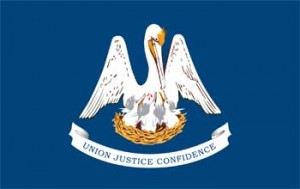Louisiana Emergency Vehicle Light State Statutes
 The lights on a vehicle can tell you a lot about the vehicle's function and purpose. Each type of emergency vehicle has their own specific light colors and light flashes that they use to identify themselves. To prevent any confusion, Louisiana regulates emergency vehicle lights very rigidily. There are specific statues in the state's laws that discuss lighting. Here is what you need to know about emergency vehicle lights in the state of Louisiana.
The lights on a vehicle can tell you a lot about the vehicle's function and purpose. Each type of emergency vehicle has their own specific light colors and light flashes that they use to identify themselves. To prevent any confusion, Louisiana regulates emergency vehicle lights very rigidily. There are specific statues in the state's laws that discuss lighting. Here is what you need to know about emergency vehicle lights in the state of Louisiana.
Police lights
The Louisiana statute 32:318(C)provides plenty of detailed instruction for the type of lights used on law enforcement vehicles. The law requires police vehicles to have two signal lamps mounted as high and as widely spaced as possible that display red flashing lights from both the front and the back of these vehicles. They are also allowed to have a revolving red light on the roof of the vehicle instead of a flashing red light. All of these red lights must be bright enough to be visible at 500 feet during normal sunlight. These lights should be alternately flashing red police lights. Law enforcement vehicles are allowed to use blue colored electric emergency lights in place of the red lights that shine towards the front of the vehicle.
Fire truck lights
Fire truck light policies change depending on whether the item is publicly owned or privately owned. Statute 32:318(C) applies to both privately and publicly owned vehicles for the fire truck department. This law requires them to have signal lamps that are mounted as high on the vehicle as possible. This lamp must display two lights that flash red towards the front and two lights that flash red towards the rear. Fire fighting companies are allowed to instead choose to have a large revolving alternating red and white light on the roof encased in a clear dome if desired. According to statute 32:318(H), any publicly owned fire truck can use blue colored electric lights mounted on the rear of the vehicle as long as these lights do not exceed 50 percent of all visual lights on the vehicle. Private fire trucks may not use blue lights.
Volunteer firefighter lights
If a vehicle belongs to a volunteer firefighter, they will not need to meet the regulations laid out for standard fire trucks. Instead, statute 32:24 explains that they will need to be equipped with a red light visible from the front of the vehicle. This red light should be a flashing light positioned on either the top of the vehicle or the dashboard. It does not need to be permanently attached there, so a volunteer firefighter may choose to only place it there while responding to an emergency. Volunteer firefighters can only use an emergency signal when they are respondinging to a fire alarm, so they should not turn the light on when returning from the alarm.
Ambulance lights
The state of Louisiana has a few different laws in place regarding ambulance lights, and for the most part, ambulance lighting is very similar to fire truck lighting. General ambulance lighting falls under statute 32:318(C) that specifies that any authorized emergency vehicle have signal lamps mounted as high and as widely spaced laterally as possible. The lights need to be a flashing red color, with two lights visible from the front and the back of the vehicle. Ambulance vehicles have the option of using a revolving red light on the roof instead of the flashing red lights, and statute 32:318 (H) also allows them to add blue lights on the rear of the vehicle. If they use blue lights, the blue lights cannot exceed more than 50 percent of all lighting on the vehicle.
Tow trucks lights
Louisiana state law does not have any specific requirements for tow trucks. Therefore, tow truck drivers have a lot of leeway in selecting their lights. They just need to make sure that any lighting they select meets statute 32:309 which specifies the acceptable colors for lamps. Any front lamps must be an amber color while any back lamps may be red, amber, or yellow. Tow trucks do fall under statute 32:327 C that allows flashing lights on the presence of a vehicular traffic hazard requiring unusual care in approaching or passing. Therefore, most tow trucks in the state of Louisiana choose to use traditional front and rear lamps along with a row of flashing amber or yellow lamps to caution drivers as drivers approach.
Construction vehicle lights
 Most construction vehicles can choose to get lighting that meets the vehicular hazard warning signal regulations laid out in statute 32:320.1. This statute says that a vehicle can equip flashing lights to warn other drivers if the vehicle may present a hazard to other cars. This allows construction vehicles to mount signal lamps on the front that are spaced wide apart and show simultaneously flashing white, yellow, or amber lights. Lights in the rear should be simultaneously flashing lights in an amber or red shade. Construction vehicles equipped with warning signals should be bright enough to be viewed from 500 feet away if the vehicle is 80 inches or more wide. If the vehicle is less than 80 inches, the lights only need to be visible form 300 feet away in sunlight.
Most construction vehicles can choose to get lighting that meets the vehicular hazard warning signal regulations laid out in statute 32:320.1. This statute says that a vehicle can equip flashing lights to warn other drivers if the vehicle may present a hazard to other cars. This allows construction vehicles to mount signal lamps on the front that are spaced wide apart and show simultaneously flashing white, yellow, or amber lights. Lights in the rear should be simultaneously flashing lights in an amber or red shade. Construction vehicles equipped with warning signals should be bright enough to be viewed from 500 feet away if the vehicle is 80 inches or more wide. If the vehicle is less than 80 inches, the lights only need to be visible form 300 feet away in sunlight.
Utility vehicle lights
Many utility vehicles are trucks, truck tractors, or trailers, so they will need to meet the requirements laid out in statute 32:308. This law requires them to have amber side marker lamps and back and front clearance lamps to help other motorists more accurately view the vehicle. When parked, utility vehicles will need to satisfy statute 32:314 by displaying a white or amber lamp from the front and a red lamp from the back if there is not enough light to make the utility vehicle visible. To further warn cars of their location, utility trucks may choose to equip hazard signals as laid out in statute 32:320.1. This allows them to use flashing signals in a white or amber shade on the front and flashing signals in an amber or red shade in the back.
Pilot vehicle light
Pilot vehicles are the vehicles that accompany an oversized load to provide warning to other drivers. According to statute 32:387, a vehicle is not technically a pilot vehicle capable of escorting an oversized load unless it has a permit to operate. To qualify as an escort vehicle, the driver of the vehicle will need to go to any Weights and Standards Police Officer and gain approval for a pilot vehicle. Once they have the permit, they will be able to display the lights. Louisiana law requires the pilot vehicle to have an amber emergency warning lamp that includes bar lights, LED strobe lights, revolving lights, and stationary lamps. If the lamp is a dome shape, it must be at least 9 inches wide and 4 inches tall.
Security Vehicle Lights
Under statute 32:327 and 32:318, security vehicles cannot use the blue or green lights common in other states if they wish to drive on the road. In Louisiana, security vehicles do not get any special exemptions for lighting. This means that if they want to drive on the road, they can only use the standard lighting laid out in statute 32:303. This lighting will include white headlamps, red tail lamps,, and amber signal lamps. However, the law does allow individuals to use any color they like on private property, so vehicles that patrol mall parking lots and other regions often use flashing green or blue lights to attract attention.
For more information about what lights may be available to you, we suggest calling your State Highway Patrol office at: 225-925-6006
*Please note that these numbers are what we are currently able to find and the numbers may have changed since this listing.
Disclaimer: The emergency vehicle light state statute guide was created by Extreme Tactical Dynamics as a guide and reference. We make no claim to the accuracy or validity of this guide. This guide was written to the best of our knowledge and has been provided to our customers as a courtesy ONLY! The information in this guide is our interpretation of the law as we have read it. We cannot be held responsible for any errors as this is only our interpretation of the law and the laws are constantly changing. We cannot be held liable or responsible for any errors and recommend that our customers refer to their local authorities to confirm the particular statue that governs their use of emergency vehicle lights.
 Facebook
Twitter
Google+
Instagram
YouTube
Facebook
Twitter
Google+
Instagram
YouTube


